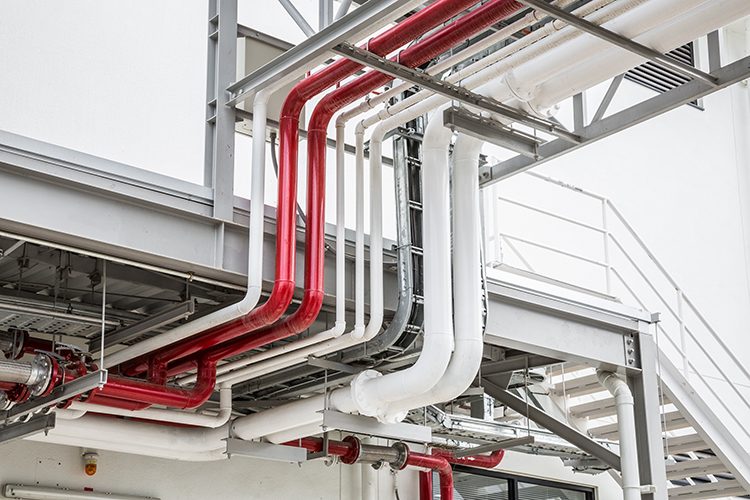Improper Disinfection of Premise Plumbing Systems Can Damage Piping, Part 1
Toxic and corrosive chlorine levels are used to decontaminate water piping in buildings; the industry has no standard specifically for dealing with this subject.

When it comes to flushing and disinfection, many premise plumbing systems or building water distribution systems are being destroyed by improper disinfection and flushing methods. Since 1997, both model codes, the International Plumbing Code and the Uniform Plumbing Code, have contained sections addressing flushing and chlorine disinfection of potable water distribution systems before use (see Sec. 610.1 IPC; Sec. 609.9 UPC).
Flushing and disinfection are also performed as an emergency measure after Legionella bacteria or some other waterborne bacteria is found or suspected in a building’s water system or after a building has been unoccupied for a long period and before re-occupancy, such as what occurred during the height of the COVID-19 pandemic. All these flushing and disinfection events are performed with toxic and corrosive chlorine levels.
For some years now, we have been aware that piping systems — including pipe, fittings, valves and equipment — are damaged by these well-intended but ill-performed hyper-chlorination events. Simply put, they cause corrosion and oxidation damage to piping systems, leading to brittleness, stress cracks and leaks, resulting in significant economic losses.
Neither model plumbing code provides a detailed protocol for how flushing and disinfection of the plumbing system are to be performed. The disinfection protocols outlined in American Water Works Association (AWWA) Standards C651 and C652, which address disinfection of utility water mains and water-storage facilities, respectively, are not readily translatable to premise plumbing/building water systems. Currently, no standard is directed toward flushing and disinfection of such systems.
Disinfection procedures to kill or eradicate Legionella bacteria require chemical dosages at significantly greater levels than those employed to control the growth of Legionella bacteria as part of a daily, secondary water treatment system. Note that there is no standard for implementing secondary water treatment systems, including the type and method of control, other than compliance with the EPA’s Safe Drinking Water Act (1974).
Initial and emergency disinfection methods include using hyper-chlorination (or high concentrations of other water treatment chemicals) that are often corrosive to many piping materials, including copper. The more chlorine or water treatment chemicals added to the water, the more corrosive and damaging it is to the interior of the piping system. Eventually, the water treatment chemicals oxidize and cause stress crack corrosion that can lead to massive failures or pinhole leaks.
When oxidation occurs, it attacks ferrous metals the most, followed by copper and copper alloy (brass), then plastics. One plastic material, chlorinated polyvinyl chloride (CPVC), stands out as a little more resistant to chlorine than other piping materials because chlorine is in the molecular structure that makes up this plastic. Schedule 80 CPVC piping is what I have recently specified because of the additional wall thickness, which increases the pressure rating.
However, as with any piping material, it is important to check with the manufacturer’s technical literature for chemical resistance charts and pressure and temperature limits.
Pipe Materials in Building Water Systems
Both model plumbing codes allow the following pipe materials in building water service pipe (from the water main to the building) and in water distribution systems within buildings:
- Acrylonitrile butadiene styrene (ABS)
- Chlorinated polyvinyl chloride (CPVC)
- Chlorinated polyvinyl chloride/aluminum/chlorinated polyvinyl chloride (CPVC/AL/CPVC)
- Copper (Type K, L, M)
- Cross-linked polyethylene (PEX)
- Cross-linked polyethylene/aluminum/cross-linked polyethylene (PEX/AL/PEX)
- Cross-linked polyethylene/aluminum/high-density polyethylene (PEX/AL/HDPE)
- Ductile iron
- Galvanized steel
- Polyethylene (PE)
- Polyethylene/aluminum/polyethylene (PE/AL/PE)
- Polyethylene of raised temperature (PE-RT)
- Polypropylene (PP)
- Polyvinyl chloride (PVC)
- Stainless steel, Type 304
- Stainless steel, Type 316
Pipes fittings, valves and equipment in building water systems can be affected by pressure, temperature, water chemistry and water treatment chemical levels. It is important to note that every pipe material on the list can be damaged when water treatment chemical levels exceed the piping manufacturer’s recommended maximum chemical exposure levels.
Chlorine is not known to damage or corrode plumbing in buildings when chlorine levels are below 2 parts per million (ppm) for continuous exposure. Still, no material on the list can withstand continuous exposure to high chlorine levels, monochloramine or chlorine dioxide.
Both metallic and plastic pipe will oxidize and corrode exponentially faster as an oxidizing water treatment’s chemical concentration increases. The active form of chlorine in water is hypochlorous acid. For this acid to form and be active, it needs slightly alkaline water.
Any level of chlorine over 5 ppm turns the water acidic. Once acidic, the chlorine becomes more and more corrosive to the piping system, including the pipe, joints, fittings, valves, equipment and fixtures.
IPC Code Requirements for Disinfection
For many years, the International Plumbing Code has required flushing and chlorine disinfection of the water distribution/premise plumbing systems prior to usage/new building occupancy:
“602.3.4 Disinfection of System (2021 International Plumbing Code)
“After construction, the individual water supply system shall be purged of deleterious matter and disinfected in accordance with Section 610.
“Section 610 Disinfection of Potable Water System (2021 International Plumbing Code)
“610.1 General.
“New potable water systems shall be purged of deleterious matter and disinfected prior to [use]. The method to be followed shall be that prescribed by the health authority or water purveyor having jurisdiction or, in the absence of a prescribed method, the procedure described in either AWWA C651 or AWWA C652, or as described in this section. This requirement shall apply to ‘on-site’ or ‘in-plant’ fabrication of a system or to a modular portion of a system.
“1. The pipe system shall be flushed with clean, potable water until dirty water does not appear at the [outlet points].
“2. The system or part thereof shall be filled with a water/chlorine solution containing not less than 50 parts per million (50 mg/L) of chlorine, and the system or part thereof shall be valved off and allowed to stand for 24 hours; or the system or part thereof shall be filled with a water/chlorine solution containing not less than 200 parts per million (200 mg/L) of chlorine and allowed to stand for [three] hours.
“3. Following the required standing time, the system shall be flushed with clean potable water until the chlorine is purged from the system.
“4. The procedure shall be repeated where shown by a bacteriological examination that contamination remains present in the system.”
This well-intended code section (Sec. 610.1, IPC) tells the building owner/manager and contractors that there are at least five options for choosing a flushing and disinfection method for a premise/building plumbing system before use in two main hierarchies of preference.
When we break down this code section to its parts, it tells us that in choosing a disinfection method, we should:
First, pay attention to either of the following two sources to see if a method of disinfection exists:
1. The method prescribed by the health authority (I have never come across any such document);
2. The method prescribed by the water purveyor (this would typically be the water utility, and I have never encountered any such document).
Second, if no method has been prescribed by the above sources, then choose between any of the following methods:
3. The method set forth in the AWWA Standard C651, Disinfecting Water Mains;
4. The method outlined in AWWA Standard C652, Disinfection of Water-Storage Facilities;
5. The “method described” in this code section.
UPC Code Requirements for Disinfection
The 2021 Uniform Plumbing Code section addressing disinfection conveys essentially the same information as the International Plumbing Code except for two differences:
“609.10 Disinfection of Potable Water System. (2021 Uniform Plumbing Code)
“New or repaired potable water systems shall be disinfected prior to use where required by the Authority Having Jurisdiction. The method to be followed shall be that prescribed by the Health Authority or, in case no method is prescribed by it, the following:
“1. The pipe system shall be flushed with clean, potable water until potable water appears at the points of the outlet.
“2. The system or parts thereof shall be filled with a water chlorine solution containing not less than 50 parts per million of chlorine, and the system or part thereof shall be valved-off and allowed to stand for 24 hours; or, the system or part thereof shall be filled with a water-chlorine solution containing not less than 200 parts per million of chlorine and allowed to stand for [three] hours.
“3. Following the allowed standing time, the system shall be flushed with clean, potable water until the chlorine residual in the water coming from the system does not exceed the chlorine residual in the flushing water.
“4. The procedure shall be repeated where it is shown by a bacteriological examination made by an approved agency that contamination persists in the system.”
First, unlike the IPC, which requires disinfection of “new potable water systems,” the UPC requires disinfection of potable water systems prior to use only if the authority having jurisdiction first requires it.
This means that no disinfection of any premise/building plumbing system is legally required in any jurisdiction adopting the UPC unless the jurisdiction (state/city adopting the UPC) amends the UPC to make this section mandatory or unless there exists a procedure for a local building authority to require disinfection, which would seemingly only be enforced on a case-by-case basis through the permitting process.
Of course, the parties to a construction contract are free to set the terms of their contract and require disinfection of potable water systems (of any method) prior to use, but that should not be seen as a legal equivalent to a code requirement.
Second, if disinfection is required by the authority having jurisdiction, then the UPC tells the building owner/manager and contractors that there are only two options when it comes to choosing a flushing and disinfection method for a premise/building plumbing system prior to use in a hierarchy of preference:
1. The method prescribed by the health authority (I have never come across a health department flushing and disinfection procedure document);
2. The “method described” in this code section (which section is written in the same terms as the IPC “method described” in its corresponding disinfection section).
While these sections in the IPC and UPC address flushing and chlorine disinfection of building water systems/premise plumbing systems prior to usage/new building occupancy, there is no plumbing or building code section addressing emergency flushing and disinfection of existing or currently in-use building water/premise plumbing systems after Legionella bacteria or some other waterborne bacteria is found or suspected in a building’s water system, or after a building has been unoccupied for a long time and before re-occupancy, such as during COVID-19.
Flushing and disinfection of a piping system that has been in use require something different than that for flushing and disinfection of a new plumbing system.
Next month, we’ll discuss how to disinfect these water piping systems.





